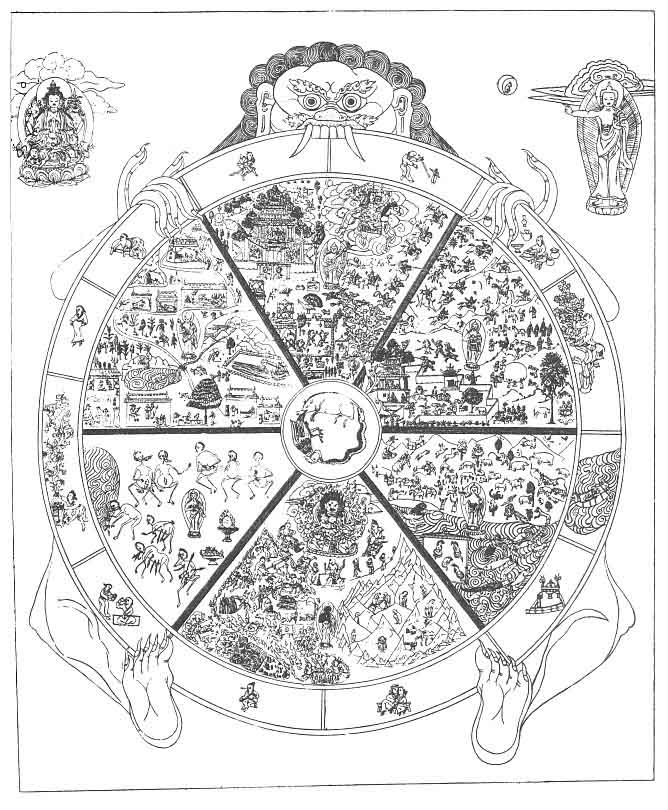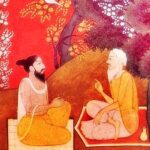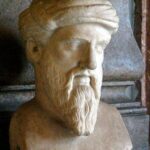Buddhist Philosophy: Impermanence, Suffering and the “No-Self”
Running parallel to the maturation and evolution of Hellenic philosophy, to the East the Indo-Aryan people were going through a similar intellectual revolution from the prevalence of ritual and ceremonial worship of gods and goddesses embedded in their mythologically steeped traditions as preserved in their Hindu (Vedic) scripture, to a more speculative and metaphysical mode of inquiry into the nature of reality and existence and its relationship to change, impermanence, and the immortality of the Soul, or Self (Ātman) as it was referred to in the Vedas.
The aim of this inquiry, again just as it was in the West in the Hellenic philosophical tradition which was emerging at contemporaneously, was to explain not only the nature of reality, Being, or existence, but also mankind’s place in as well as expound upon the goal of life, i.e. happiness, enlightenment, nirvana, liberation, mokṣa, eudaimonia or whatever other term the specific theo-philosophical tradition chose to denote this idea. Unique to the Indo-Aryan philosophical tradition, which was also shared by Buddhism its close cousin, was that there existed a path to the ultimate liberation of the human Soul, by means of which death itself could be overcome. This belief system was not just steeped in the notion of realization, or absolute knowledge (vidyā), that which was spoken of by the great sages or seers of old, i.e. the rishis, but also was characterized and underpinned by a system of metaphysics within which the nature of the Soul could be understood, and through which the means by which the Soul could be ultimately liberated rested upon. This fundamentally intellectual development was driven not only by the analysis, commentary and interpretation of the more esoteric and philosophical aspects of the Vedas, or more specifically the Upanishads, but also by the teachings of Siddhārtha Gautama, the historical figure who is the founder of Buddhism.
Buddhism takes root in the Indian subcontinent toward the end of the 5th century BCE or so, originating in the northeast border between modern India and Nepal where Siddhārtha Gautama was born (and where he presumably taught as well) at around the same time that the first of the Upanishads were compiled. In modern academic literature, Buddhism is typically considered to be part of a broader philosophical movement that arose as an alternative to Vedic religion in the first half of the first millennium BCE in the Indian subcontinent called Śramaṇa. This movement included Jainism, as well as other heterodox – i.e. not adhering to the Vedas as authoritative scripture – theo-philosophical schools of thought.[1]
The rise and influence of Buddhism then must be seen within the context of a broader intellectual movement that arose on the outskirts of the ancient Indo-Aryan civilization which reflected a basic and fundamental dissatisfaction with Vedic philosophy, culture and tradition as a means to liberation. It represented almost a rebellion of sorts to the orthodox theological and religious dogma that was prevalent at the time which was encased within a very structured and elitist socio-political structure, i.e. Varna, which closely guarded theological study and knowledge by a specific class of society, i.e. the Brahmins, and which held that mokṣa, or immortality, was to be practiced only by the well trained and select few. Siddhārtha , after much trials and tribulation, and after following many different paths and teachings, concluded that the prevailing orthodox Vedic philosophical system as a means to liberation or happiness was fundamentally flawed and after his Awakening, came up with an alternative philosophy (and underlying metaphysics) which became the basis of Buddhism in all its different variants today.
The popularity and spread of Buddhism in the Indian subcontinent in the last half of the first millennium BCE, which spread all the way into the Far East and regions of Chinese cultural influence in the first few centuries of the Common Era and beyond, along with the establishment of Vedic philosophy as represented in the Upanishadic literature, is in many respects directly analogous theo-philosophical development in the Hellenic world which arose out of the prevailing mythological and theological based religious traditions from which our modern (Western) notion of philosophy itself was conceived. It can also be understood as analogous to the Christian revolution in the first few centuries of the Common Era as Jesus of Nazareth rejected the fundamental teachings of Judaism and proclaimed his new philosophy, i.e. the “Gospel”, for which he was ultimately crucified. The teachings of Jesus, who later became known as Christ or Logos personified, as interpreted and compiled by his followers who founded Christianity as we know it today, not only rejected the religion of the Hebrews (of which Jesus was of course a member), but also the so-called “pagan” religions that were prevalent in the Mediterranean at the time, proclaiming that not only was there one true God as the Hebrews had done before him, but that this God was accessible to, and was in fact indistinguishable from, the very inmost essence of all mankind.
But Christianity as well, in its formation in the after the death of Jesus and as the Church and its associated religious dogma became codified and canonized into the Bible, also integrated Hellenic theo-philosophy as well, this element of Christianity being specially emphasized by the early Christian Church Fathers. Just like Jesus then, Buddha rejected the religious traditions of his forefathers proposed not only an altogether different theo-philosophy, but also a fundamentally different worldview, i.e. metaphysics, as well as a completely different means and approach by which the ultimate goal of life could be reached, a goal which he defined as the cessation of suffering. Buddhism then was born out of Hinduism just as Christianity was born out of Judaism, and Buddha was a Hindu just as Jesus was a Jew.
After searching for keys to unlock the secret of human suffering in his many years of wandering after he left behind his family and kingdom, Buddha ultimately came to find that none of the teachings he encountered answered his questions satisfactorily, and therefore he rejected Vedic philosophy in all its variations and after his “Awakening”, came to understand and teach a practical handbook of sorts for all seekers of Truth and Knowledge, a much more simplified and practical philosophy, a way of life really, than was then offered by the more traditional orthodox Vedic philosophical schools.
The mythical narrative surrounding the birth, life and death of the Prince Siddhārtha is consistent with the narratives of most pre-historical heroic figures (Jesus, Hercules, etc.) and starts with stories of his immaculate conception into a ruling family in the foothills of the Himalayas in Northern India. It is said that upon his birth, which his mother did not survive, he was visited by a great sage who predicted that he would either be a great ruler of men or a great religious teacher and reformer (holy man). His early childhood and young adulthood was spent living the life of luxury within the confines of multiple palaces and exposed to all the pleasures that one might expect were accessible to a prince. It is said that his father, given the prophecy upon his birth of the potential for his son to be a great religious prophet and teacher, took great pains to shelter him from any outside influences that would expose him to the suffering and harsh realities of the world which in turn might lead to his renunciation of his birthright. It is said that he married and had a son and spent the first 29 years of his life in the sheltered and elaborate palace of his father where no desire of his was left unfulfilled.
In his late twenties, a story is told that one day he left the palace of his own volition to view his subjects and kingdom first hand, despite the misgivings and sheltering instincts of his father. On this journey outside the palace walls, he was exposed to his first examples of the great suffering of the world, seeing first an old man on the verge of death, then a diseased man in great suffering and pain, followed by the corpse of a dead man, and lastly by an ascetic monk who had renounced the world in the classic Vedic monastic tradition which was prevalent at the time. This experience is said to have completely transformed his view of the world and invoked feelings of tremendous and overwhelming compassion for the plight of his people, inspiring him to renounce his royal pedigree, leave his wife and child, and begin to live the life of an itinerant wandering monk to search for truth and the meaning of life, which was from his perspective the source and possible secret to the end of suffering.
Prince Siddhārtha then spent the next several years following various forms of extreme Vedic asceticism and renunciation to try and find the true nature of existence and the path to illumination as prescribed by the teachings of the Vedas, with each successive path and teaching that he followed getting him no closer to the answers to the questions that he was seeking. It is then said that after practicing these extreme forms of renunciation and deprivation that led him close to the edge of death, he finally gave up these practices as fruitless and settled down under a Bodhi tree (believed to be in Bodh Gaya, India), and resolved to sit in contemplation until either the solution to the nature of suffering and its ultimate liberation was revealed to him or die in the process.
Great Buddha Statue, located in Bodh Gaya in Northeastern India.[2]
After supposedly sitting in deep meditation for some 49 days, being tempted during his practice by various demons and gods with all sorts of worldly temptations to lead him astray (think Jesus’s 40 days and 40 nights in the desert having been tempted by Satan), at the age of 35 Siddhārtha Gautama achieved enlightenment and arose as the Buddha the name being derived from the root Sanskrit verb ”to know”, or budh, meaning “one who is awake”, i.e. the Awakened One. The term Buddha, or Buddha Nature, has come to represent the eternal and ever-present nature of truth and existence which he came to embody after his enlightenment experience under the Bodhi tree.
Upon emerging from this deep and ultimately transformative experience, which was supposed marked by a great earthquake when his state of enlightenment was achieved and the eternal truth and knowledge of the nature of suffering and the path by which it could be overcome was revealed to him, Prince Siddhārtha became Buddha. Although initially reticent to teaching this new found knowledge to the rest of mankind, believing that everyone was too steeped in ignorance and worldliness to understand, comprehend and ultimately practice the eternal Truth which was revealed to him, it is said that he was convinced by one of the great Indian deities, Brahmā Sahampati, to at least try to teach for the good of mankind.
Thus began the teaching phase of his life from which the philosophical system of Buddhism as we know it today has been handed down to us. It is said that he traveled throughout India and taught his Four Noble Truths and Noble Eightfold Path, as well as instituted the practices of Buddhist monasticism, for some 45 years until his death sometime in the 5th or 4th centuries BCE. These teachings, sometimes referred to as his Buddha Dharma, or the Way of Buddha, represented a complete explanation and exposition of the laws of nature as they applied to the problem, and ultimate solution, of human suffering which was from his perspective the end goal of any theological or philosophical pursuit. He taught how the great cycle of birth, disease, decay and dying could be overcome by proper understanding, or knowledge of reality, or more precisely the shedding of ignorance of the existence of the Self and attachment to which to Buddha attributed the source of suffering.
The historical figure we know today as Buddha was raised on the northern Indian/Nepal border in the foothills of the Himalayas as a prince from an affluent ruling family, living and teaching somewhere between the end of the sixth and early part of the 4th centuries BCE but dated by most scholars to the 5th century BCE. What we know about the historical figure named Siddhārtha Gautama who later became known as the Buddha, is from a corpus of textual material written that is handed down to us in in Pāli[3], as well as somewhat later Sanskrit, Tibetan and Chinese transliterations of the Pāli texts. The Tripitaka, or Pāli Canon, which is term used for the orthodox and authoritative Buddhist texts, cover not only his teachings, but also include biographic material as well, the latter of which is interspersed with a variety of mythical accounts that established him as a pseudo-divine figure who was born to deliver his message for the good of mankind. Tripitaka (Tipitaka in Pāli), means literally “three baskets”, and while the earliest parts of the canon are believed to have been compiled or transcribed within a few centuries after Buddha died, the biographic material is believed to have been incorporated into the corpus in the 2nd and 3rd centuries CE.
Siddhārtha Gautama, or the “Awakened One” as he was referred to by his followers, is one of the most prominent and influential theo-philosophical teachers from antiquity whose influence has spread over the centuries from the Indian subcontinent throughout most of Asia and now in modern times to the West. In many respects the Pāli Canon and teachings of the Buddha which are contained therein can be seen as analogous to the Four Gospels which contain various narratives of the life and teachings of Jesus of Nazareth and form the core part of the New Testament of the Bible which were written some decades after his death and were only later included as part of the Biblical canon.
According to most scholarly accounts, it is the Pāli Canon that represents the oldest authoritative Buddhist scripture. This strain of Buddhism that considers the Pāli Canon to be the authoritative Buddhist scripture is referred to as Theravada Buddhism[4] as opposed to the slightly more possible and well known variant of Buddhism, at least in the West, called Mahayana Buddhism – of which the more widely known schools of Zen Buddhism and Tibetan Buddhism are representative for example – and relies on a different set of scriptures than the Theravada school referred to as the Agamas (“sacred work” or “scripture” in Sanskrit or Pāli), which are written in Classical Chinese and referred to as the Chinese Buddhist Canon, or Dàzàngjīng (大藏經).
Mahayana literally means “Great Vehicle” in Sanskrit and focuses more on the monastic aspects of Buddha’s teachings and emphasizes the, rules, rites and practices for those who wish to pursue enlightenment for the good of all sentient beings as Buddha himself did. These enlightened beings are called bodhisattvas, or “enlightened beings” in the Mahayana school and while the Mahayana school does not necessarily differ from the Theravada tradition (which precedes it historically) in terms of basic philosophical tenets and practices, it nonetheless developed a unique and relatively independent scriptural and philosophical tradition which codified and institutionalized specific doctrines, teachings and practices for the pursuit and attainment of enlightenment, what perhaps Buddhism in modern parlance is best known for.
Despite their differences in interpretation and practices, each adheres to the core basic teachings of Buddha as reflected in his Four Noble Truths and the Noble Eightfold Path, the latter of which outlines the true nature of reality and the causes of suffering and the former which outlines the intellectual and metaphysical basis for the basic precepts and practices which are to bring about the cessation of suffering and ultimately enlightenment and the end if the cycle of death and rebirth. While Buddhism does not lay out a philosophic doctrine per se, at least not in the classic Western sense of the term, nor does it lay out any systemic laws or beliefs as is characteristic of the Abrahamic religions, it does however lays out basic fundamental precepts about the nature of life and reality from which it establishes a path, the so called “Middle Way”, which is the means by which the bonds of attachment which ultimately lead to suffering can be broken for good, resting on the fundamental assertion that not only is enlightenment possible, but that there is a specific path which can be followed which will ultimately lead to nirvana, the term given to the cessation of suffering and the end of the Wheel of Dharma.
When analyzing the teachings of Buddhism, as reflected in the various textual sources which were compiled by his followers sometime after his death, we are left with very similar challenges and pitfalls when studying the philosophy of all of the great teachers in antiquity. While we can optimistically assume that his precise teachings and doctrines, words and phrases and terminology , were faithfully transcribed by his followers even if several generations of teacher and student transmission existed before any of the actual texts which codify his teachings were transcribed, we still nonetheless have to try and extract what he actually said and taught from the extant literature – for the texts were written in a variety of languages that a) in all likelihood do not reflect the actually language that he spoke, and b) we do know that he did not leave any written materials behind himself.
According to tradition, the transcription of the Pāli Canon is the result of the Third Buddhist Council that was convened at the behest of the pious Indian emperor Ashoka Maurya (304-232 BCE) who ruled much of the Indian subcontinent in the third century BCE. His intent for convening the council, much like the Christian councils that were convened in the 3rd century CE onward, was to standardize the teachings, texts and some philosophical elements of Buddha’s legacy from amongst the various factions that had sprung forth after Buddha’s death, leading to the existence of a variety of teachers and philosophic schools who disagreed on many aspects of the Buddha’s message and precepts.
As the tradition has it, the council lasted nine months and consisted of senior monastic representatives from all around the emperor’s kingdom who debated various aspects of Buddhist doctrine, culminating in the canonization of the scripture, i.e. the establishment of the Pāli Canon, and formation of the foundational principles and practices of Theravada Buddhism. After the council, it is said that the emperor dispatched various monks who could recite the teachings by heart to nine different locations throughout the Near and Far East, laying the groundwork for the spread of Buddhist teachings and philosophy not just in the Indian subcontinent, but throughout the ancient world as far East to Burma and even as far West to Persia, Greece and Egypt.
The Tripitaka contain three major sections, (in Sanskrit) the Sūtra Pitaka, the Vinaya Pitaka, and the Abhidharma Pitaka. The Sūtra Pitaka is the oldest of the three parts of the canon and is said to have been recited by Ananda, Buddha’s secretary at the First Council, a meeting of five hundred disciples of Buddha shortly after his death to compile his teachings. It is divided into five sections of sūtras which are grouped as nikayas, or “collections” – the Digha Nikaya or “Long Discourses”, the Majihima Nikaya or “Middle Discourses”, Samyutta Nikaya or “Connected Discourses”, the Anguttara Nikaya or “Numerical Discourses”, and the Khuddaka Nikaya or “Minor Collection”. Another disciple of Buddha named UPāli is said to have recited the Vinaya portion of the Tripitaka which deals mostly with rules governing monastic life, reflecting the strong undercurrent of renunciation and monasticism which was an integral part of Buddhism from its inception. The Abhidharma portion of the is the youngest material and reflects the Buddha’s teachings regarding various deities in heaven during the final period of his enlightenment and deals with various philosophical and doctrinal issues which help elucidate the some of the more esoteric and obscure aspects of the scripture.
It is from the Sūtra Pitaka portion of the Pāli Canon that we ascertain the core of Buddhist doctrine as it was understood by his followers and is interpreted by the various schools and practitioners throughout the world today.
The Four Noble Truths and the Noble Eightfold Path, the so-called Middle Way, for which Buddhism is perhaps most known for represent the very basic tenets of Buddhism in all its forms. Within this philosophical framework are included not only a unique perspective on the nature of reality itself which distinguish it from all other theo-philosophical traditions in antiquity, and in modern times, but also the basic guiding principles upon which a good and fulfilling life, and ultimately liberation and enlightenment, i.e. nirvana, or the cessation of suffering, can be achieved.
These core Buddhist tenets are primarily understood through a set of sūtras referred to as the Dharmacakrapravartanasūtram, or as it is sometimes translated, The Setting in Motion of the Wheel of Dharma. These teachings can be found in the Sūtra Pitaka, a section of Pāli Canon which is believed to represent the earliest and most authoritative text of Buddhist philosophy. This teaching, akin to Jesus’s Sermon on the Mount, is was said to be delivered to five ascetic monks (bhikkhus) with whom he had practiced austerities with after he had renounced his royal heritage and who became his first followers.
As the story is told, upon approaching his former ascetic brethren, given that they recognized that he was no longer following their extreme ascetic ways being that he was fully clothed and well fed, his former friends were at first reluctant to receive him. However, after seeing him come closer, it was clear that he was a changed man, an enlightened and illumined being of sorts, and henceforth the monks sat and eagerly received his teachings.
Then the Realized One [Tathāgato], monks, in the first watch of the night agreed (to teach) by keeping silent, in the middle watch of the night he took delight in what was to be said, in the last watch of the night he addressed the auspicious group-of-five, (saying):
“There are these two extremes, monks, that one who has gone forth ought not to descend to, which is this: being joined and clinging to the pleasure in sense pleasures, which is low, vulgar, worldly, not very noble, not connected with the goal, not (helpful) for the spiritual life in the future, not leading to world-weariness, dispassion, cessation, deep knowledge, Complete Awakening, and Emancipation [nirvana]; and this, which is not the middle practice: devotion to self-mortification, which is painful, not connected with the goal, painful in this very life and in the future where it results in pain.
Not having approached either of these two extremes, monks, the Doctrine of the middle practice [Middle Way] is being taught by the Realized One, which is this: right view, right thought, right speech, right action, right livelihood, right endeavor, right mindfulness, right concentration.
There are these Four Noble Truths, monks. Which four? Suffering, the arising of suffering, the cessation of suffering, and the practice leading to the cessation of suffering.
Herein, what is suffering? Birth is suffering also old age is suffering also sickness is suffering also death, being joined to what is not dear, being separated from what is dear, is suffering also not to obtain what one seeks for is suffering in brief. The five constituent parts (of mind and body) that provide fuel for attachment are suffering. This is said to be suffering.
Herein, what is the arising of suffering? it is that craving which leads to continuation in existence, which is connected with enjoyment and passion. This is said to be the arising of suffering.
Herein, what is the cessation of suffering? It is the complete fading away and cessation without remainder of the birth of that craving, which greatly enjoys this and that, and is connected with enjoyment and passion. This is [said to be] the cessation of suffering.
Herein, what is the practice leading to the cessation of suffering? It is the noble eightfold path [Noble Eightfold Path], which is this:
right view [samyag-dṛṣṭiḥ],
right thought [samyak-saṁkalpaḥ],
right speech [samyag-vākright],
right action [samyak-karmāntaḥ],
right livelihood [samyag-ājīvaḥ],
right endeavor [samyag-vyāyāmaḥ],
right mindfulness [samyak-smṛtiḥ],
right concentration [samyak-samādhir-iti].[5]
What we find here first and foremost in the initial part of his teaching is the fundamental belief that the basic problem of life, the one essential aspect of being to which all mankind is afflicted, is suffering. Furthermore, he outlines from the very start that his “revelation”, was not just that the nature of being or existence itself was essentially characterized by this notion of suffering (duḥkha in Sanskrit, or dukkha in Pāli)[6], but that in fact he had “discovered” the source of this suffering, as well the specific practices and principles by which it could ultimately be eliminated, i.e. what he called the “cessation of suffering”, or release from the bonds of saṃsāra which can be viewed ontologically in contrast to nirvana. These principles and this path, again the so-called “Middle Way”, are referred to as the Four Noble Truthsand the Noble Eightfold Path.
While The Four Noble Truths and Eightfold Noble Path represent the cornerstones of Buddha’s teachings, he also lays out a fairly sophisticated metaphysical framework upon which the intellectual foundations of his philosophy rests. Herein lies the philosophic portion of Buddhism, where he defines what he believes to be the true nature of “reality”, the fundamental characteristic of “being” and “existence” itself, which when properly understood, hold the key to the liberation from what is sometimes called the Wheel of Dharma.
At its core, Buddhist philosophy is based upon the notion that it is from a very basic and fundamental misconception and misunderstanding of the true nature of reality which is the cause, or source, of suffering in all its forms. It is fair to say then that Buddha’s teaching is based upon a fully rational and logical system of cause and effect, marking a stark departure – at least from his point of view – from the faith based theo-philosophical systems which dominated the intellectual landscape in the Indian subcontinent in the middle of the first millennium BCE and placing his teachings squarely within the philosophical intellectual revolution that sprung forth throughout Eurasian antiquity at that time – parallel to the Hellenic philosophical tradition to the West and the ancient Chinese philosophical tradition to the East.
The source of suffering according to Buddha’s teachings as interpreted and understood by his followers is based upon three basic “misconceptions”, or falsehoods, upon which he not only establishes his “worldview”, but also provide the rational foundation of his Four Noble Truths and in turn the Noble Eightfold Path, the basic practices and principles to be followed to end suffering once and for all. These misconceptions are referred to in the Buddhist tradition as the three marks of existence, or tilakkhaṇa in Pāli (trilakṣaṇa in Sanskrit). They are:
- Anicca(anitya in Sanskrit), typically translated as “Impermanence”[7],
- Dukkhain Pāli, duḥkha in Sanskrit, which is typically translated as “suffering” but a more literal translation might be “unsatisfactoriness”, and
- Anattā, anātmanin Sanskrit, which means literally “non-self”, or more literally translated as the “lack of existence of self”, or perhaps more aptly put as the “illusion” of self.[8]
It is from these three fundamental “misconceptions” from which our experience of suffering originates according to Buddha, and upon which the intellectual foundations of his Middle Path are based.
From the Khuddaka Nikāya, or “Minor Collection”, section of the Sūtra Pitaka called the Dhammapada, or Way of Dharma”, one of the cornerstone texts in all of Buddhist Scripture, we find the following description of these three marks of existence as they relate to the Noble Eightfold Path and Four Noble Truths[9]:
-
Of all the paths the Eightfold Path is the best; of all the truths the Four Noble Truths are the best; of all things passionlessness is the best: of men the Seeing One (the Buddha) is the best.
-
This is the only path; there is none other for the purification of insight. Tread this path, and you will bewilder Mara.
-
Walking upon this path you will make an end of suffering. Having discovered how to pull out the thorn of lust, I make known the path.
-
You yourselves must strive; the Buddhas only point the way. Those meditative ones who tread the path are released from the bonds of Mara.
-
“All conditioned things are impermanent” — when one sees this with wisdom, one turns away from suffering. This is the path to purification.
-
“All conditioned things are unsatisfactory” — when one sees this with wisdom, one turns away from suffering. This is the path to purification.
-
“All things are not-self” — when one sees this with wisdom, one turns away from suffering. This is the path to purification.
-
The idler who does not exert himself when he should, who though young and strong is full of sloth, with a mind full of vain thoughts — such an indolent man does not find the path to wisdom.
-
Let a man be watchful of speech, well controlled in mind, and not commit evil in bodily action. Let him purify these three courses of action, and win the path made known by the Great Sage.
-
Wisdom springs from meditation; without meditation wisdom wanes. Having known these two paths of progress and decline, let a man so conduct himself that his wisdom may increase.[10]
The passage above come from the chapter called Magga Vagga, or Maggavagga, typically translated as “The Way” or “Path”, and while it most likely represents a compilation of sayings and teachings of Buddha that were only later organized under a single heading or chapter, it still nonetheless philosophically connects the Eightfold Noble Path, the Four Noble Truths, and the tilakkhaṇa, i.e. the three marks of existence, arguably the three most distinctive characteristics of Buddhist philosophy.
Here, anicca (change or impermanence), dukkha (unsatisfactoriness), and anattā (no-self) are described as points of contemplation which lead one along the “path of purification”, providing the rational basis as it were of the Four Noble Truths. That is to say, it is the confusion surrounding the notion of the existence of Self (in particular as it was understood in Vedic philosophy), the illusion of any sort of permanent existence, and the recognition that anything that is “conditioned” or qualified in any way can only ultimately lead to a lack of satisfaction at some level, that form the backbone of ignorance from which the basic problem of human suffering originates from.
So these three elementary characteristics of reality, or again being, are presented as being necessary and critical to the “purification” process which underlies the means by which cessation of suffering can be achieved. It’s important to note that the intellectual system is entirely rational, and in this sense it not only marks a significant departure from the theo-philosophical systems that preceded it in the Indian subcontinent, but it also places Buddhism squarely within the context of philosophy, particularly as it was understood in classical antiquity as reflected of Logos over mythos, rather than Religion as it is most often times viewed.
These three complementary and interrelated marks of existence permeate Buddhist philosophy and reflect the fact that according to Buddha’s teaching, it is ignorance, or lack of knowledge, that is the source of basic predicament of man, and conversely that “knowledge”, or the absence of ignorance, is the source of liberation, enlightenment or nirvana. These elemental, and primarily psychic, marks of existence therefore constitute the intellectual basis upon which the Four Noble Truths are constructed, and through which as explained in this passage above, the bonds of Mara, the deity that personified desire and death which the Buddha directly encountered and overcame on his journey toward enlightenment, can be broken.
Impermanence is the cornerstone of these three principles really, as it is the common thread under which all three “illusions” or “misconceptions” can be understood. It is mankind’s lack of recognition of the true nature of impermanence, as it relates to existence itself, which represents the fundamental ignorance, again the lack of knowledge, which is at the very root of the of the problem of human suffering according to Buddha. It is the very core of the intellectual problem as it were, a problem which rests on the principles of reason and causality, and therefore represents the “thorn” which must be removed in order that this “chain of causality” which underlies the problem of suffering can be broken. Impermanence then, is the basic metaphysical and philosophical tenet upon which all Buddhist philosophy fundamentally rests, the contemplation and full realization of which – again knowledge or lack of ignorance surrounding the true nature of – becomes the essential component of the attainment of nirvana.
From the Samyutta Nikaya portion of the Sūtra Pitaka, we find further explanation of this notion of impermanence, anicca, and how it is directly associated to the principle of “non-self”, anattā or anātman .
The perceiving of impermanence, bhikkhus [monks], developed and frequently practiced, removes all sensual passion, removes all passion for material existence, removes all passion for becoming, removes all ignorance, removes and abolishes all conceit of “I am.”
Just as in the autumn a farmer, plowing with a large plow, cuts through all the spreading rootlets as he plows; in the same way, bhikkhus, the perceiving of impermanence, developed and frequently practiced, removes all sensual passion… removes and abolishes all conceit of “I am.” — SN 22.102[11]
The direct causal relationship between impermanence (anicca) and “suffering” (dukkha) is described as being caused by this illusion of self, this notion that “I am”, or that “I exist”, something that Buddha clearly saw as not only flawed, but totally based upon falsehoods and misconceptions surrounding the nature of reality. But in this sense Buddha’s teaching is not all that revolutionary. The idea that a misconception of the idea of self, or soul, or confusion surrounding the nature of existence was at the very heart of the philosophical revolution throughout the classical period of Eurasian antiquity. But this intellectual connection between these misconceptions, and the full acceptance of the rule of cause and effect in not just the domain of philosophy but also theology, or metaphysics, is surely one of the very unique and lasting contributions of Buddhist philosophy. Suffering then, is directly causally linked to impermanence itself, and once this is established and truly understood, it then becomes possible to eradicate it entirely.
“The body, bhikkhus [monks], is impermanent. What is impermanent, that is suffering. What is suffering, that is not-self. What is not-self [should be considered as] ‘This is not mine,’ ‘I am not this,’ ‘This is not myself’: in this manner it should be seen according to actuality with perfect wisdom.
“Feeling is impermanent… Perception… Mental activities… Consciousness is impermanent. What is impermanent, that is suffering. What is suffering, that is not-self. What is not-self, should be considered, ‘This is not mine,’ ‘I am not this,’ ‘This is not myself’: in this manner it should be seen according to actuality with perfect wisdom.” — SN 22.15[12]
Here, impermanence and suffering are not only “causally” equated, but the attainment of perfect wisdom, the end goal of Buddhist philosophy from which one can liberate themselves from suffering, is described as the practice of, and full and complete recognition and understanding of, the lack of existence of this notion of “self”, i.e. anattā. It is this notion of “not-self” (in Sanskrit anātman) which in fact represents the major philosophical departure from the prevailing philosophical doctrines of the Vedic schools of philosophy which rest squarely not only on the existence of “self”, or Ātman, but also its indivisibility and ultimate unity with the Cosmic Self, or Brahman, the existence of which Buddha also denies.
So impermanence and confusion regarding the idea of one’s one existence, become the cornerstone elements of Buddhist philosophy, ideas which are born out of the Vedic philosophical tradition from which Buddha is exposed during his journeying and wandering days, but which represent an almost complete inversion of the system itself, a system which is based upon reason, logic and causality rather than ritual, scripture or blind faith.
The important and relevant rational and logical deduction here however with respect to the Buddhist doctrine of impermanence and its relationship to suffering, and in turn the existence of a path or way by which suffering can be eliminated, is that this idea of self-existence itself is fundamentally flawed, hence the importance of the notion of “not-self”, anātman, in the Buddhist philosophical tradition, which when fully comprehended and “realized”, can form the intellectual basis upon which suffering, duḥkha, itself can be completely, utterly, entirely and absolutely eliminated and bring about nirvana.
Buddhism as a belief system, a philosophy and/or way of life rather than a theology or a religion in the classic Western sense, does nonetheless depend upon some basic soteriological, i.e. salvation based[13], assumptions which provide the underpinnings of the soteriological framework as it were. First, Buddhism at its core presumes that the basic problem of existence is not in fact god realization or the attainment of heaven after death or even immortality but the avoidance of suffering, i.e. duḥkha, and in this sense the system is aligned not only with the rest of Indian philosophy but also Indo-European philosophy in a broader sense.
Second, while it does not posit a specific system of metaphysics or theological framework, it does presume that reality, life or existence, while not completely rational and materialistic necessarily, in the Western philosophical sense of those terms, it does nonetheless rest on basic principles of causality (karma) and is in turn driven by a sense of “self”, be it illusory or not. To further illustrate the implications of this point, while from a Buddhist perspective the notion of Fate versus Free Will is not directly addressed, at least not by Buddha as we understand him through the extant material attributed to him, one can safely assume that Buddha presumes the existence of Free Will even if he denies the existence of the Soul (anātman) as inferred by the laying out of a specific path, i.e. the so-called Middle Way, in order for the goal, i.e. nirvana, to be reached and for suffering, a basic elementary quality of existence, to cease.
And lastly, while Buddha fails to weigh in on the basic underlying metaphysical structure of existence, from which any sort of theology would be based in fact (akin to Daoism in this respect), one can infer that reality, or existence, to Buddha is fundamentally non-dual, i.e. monistic. From this perspective, again which is not explicit in anything we have directly attributed to Buddha himself, nirvana can be seen as the partaking of, or final dissolution into, that state of Being (in the Platonic sense) from which the material universe, everything that changes and has form (including mental perceptions and fluctuations of mind, which are incorrectly attributed to a sense of “Self”) Becoming in the Platonic sense, has its origins.
The spread of Buddhism at the time of emperor Ashoka (260–218 BCE).[14]
It is no wonder that Buddhism flourished in the Far East as from a philosophical standpoint it fits very neatly with the underlying Daoist and Yīn-Yáng belief systems, and complements Confucian thought as well. In the new socio-cultural context that was ancient China it’s lack of metaphysical or theological position can be looked upon as a strength rather than a weakness and no doubt facilitated its adoption as it moved outside of the Indian subcontinent.
[1] Śramaṇa (Samaṇa in Pāli) is a Sanskrit word meaning “seeker”, or “one who performs acts of austerity”, or simple an “ascetic” and is used to refer to several Indian theo-philosophical intellectual developments that emerged in the first half of the first millennium BCE as distinct, and in opposition to, the more prevalent orthodox Vedic tradition which came to represent the basis of the Hindu faith, hence their categorization as heterodox. These intellectual theo-philosophical developments and schools of thought ran directly parallel, and are believed to have influenced, the philosophy of the Upanishads. Theo-philosophical traditions such as Jainism, Buddhism, as well as the lesser known traditions such as Ājīvika, Ajñana and Cārvāka are all considered to be part of the Śramaṇa movement. Classical Indian philosophical conceptions such as saṃsāra and mokṣa are believed to have originated within these schools of thought, conceptions that were later integrated into some of the major Indian philosophical schools such as Yoga and Sāṃkhya. See Wikipedia contributors, ‘Śramaṇa’, Wikipedia, The Free Encyclopedia, 18 September 2016, 02:20 UTC, <https://en.wikipedia.org/w/index.php?title=%C5%9Arama%E1%B9%87a&oldid=739942627> [accessed 18 September 2016] as well as the Stanford Encyclopedia of Philosophy entry on Buddha: Siderits, Mark, “Buddha”, The Stanford Encyclopedia of Philosophy (Spring 2015 Edition), Edward N. Zalta (ed.), URL = <http://plato.stanford.edu/archives/spr2015/entries/buddha/>.
[2] From Wikimedia commons, Wikipedia contributors, ‘Bodh Gaya’, Wikipedia, The Free Encyclopedia, 8 October 2016, 17:50 UTC, <https://en.wikipedia.org/w/index.php?title=Bodh_Gaya&oldid=743235279> [accessed 8 October 2016].
[3] Pāli is a Prakrit language native to the Indian subcontinent, believed to have originated in Northern India, and very closely related to Sanskrit, with most words existing in both languages with simple phonetic transliterations between the two. Pāli is a language in the Indo-European/Indo-Iranian language family whose main historical significance is that it is the language of one, if not the, main source of Buddhist scripture and philosophy.
[4] The Pāli word Theraveda translates into the English loosely as “school of elderly monks”.
[5] From Dharmacakrapravartanasūtram, The Discourse that Set the Dharma-Wheel Rolling, edited and Translated by Anandajoti Bhikkhu, August 2009 pgs 9-10. According to the author this translation is from the Sanskrit text Lalitavistara (literally “An Elaboration of the Play [of the Buddha]”), one of the central texts of the Mahāyāna school of Buddhism which begins with Buddha’s decision to leave Heaven, and then follows the narrative of his birth life and practices until his Awakening, culminating with this final discourse delivered to his former 5 ascetic monastics which become his first disciples and to which he delivers his sermon on the Four Noble Truths and the Eightfold Noble Path, i.e. the Dharmacakrapravartanasūtra. Note that while the text of the Sanskrit version is very close to the extant Pāḷi version of the Discourse, there are some variations albeit minor, speaking to the consistently of the transmission of the content of the discourse itself.
[6] Dukkha is the opposite of the Pāli and Sanskrit word sukha, which meaning “happiness,” “comfort” or “ease”. See Wikipedia contributors, ‘Sukha’, Wikipedia, The Free Encyclopedia, 14 April 2016, 23:28 UTC, <https://en.wikipedia.org/w/index.php?title=Sukha&oldid=715303916> [accessed 14 April 2016].
[7] The Pāli word anicca is a compound word consisting of “a” meaning “non” or “lack of”, and nicca meaning “constant, continuous, permanent”, denoting that which is literally “not permanent” or “not lasting”.
[8] See Wikipedia contributors, ‘Three marks of existence’, Wikipedia, The Free Encyclopedia, 6 October 2016, 10:04 UTC, <https://en.wikipedia.org/w/index.php?title=Three_marks_of_existence&oldid=742873817> [accessed 6 October 2016].
[9] The Pāli word Dhammapada is a compound of two words, dhamma, which is equivalent to the Sanskrit word dharma, and pada. Dhamma is not only a key Buddhist philosophical term, but also an important word and concept in orthodox Indian philosophy as well. In the Buddhist tradition, it is sometimes used to denote Buddha’s teachings as a whole, or alternatively it can mean simply “righteousness”, or “way” or “path”. Pada means “foot” in Pāli, and therefore in this context Dhammapada can be understood to denote the way of truth or righteousness. The word is certainly reminiscent of the elemental Chinese philosophic notion of Dao, which is also typically translated as “way” or “path”. The Dhammapada consists of 423 verses and is classically organized into 26 separate chapters or headings, all of which contain sayings and teachings which are attributed to the Buddha himself. Many of the verses and passages in the Dhammapada can be found in other parts of the Pāli Canon as well, signifying their importance within the context of Buddhist teachings as a whole.
[10] Dhammpadda. Chapter XX, Maggavagga: “The Path”, pgs 273-289. Translated from the Pāli by Acharya Buddharakkhita, 1996. at http://www.accesstoinsight.org/tipitaka/kn/dhp/dhp.20.budd.html.
[11]Samyutta Nikaya, 22.102. Translation by John D. Ireland 2006. From http://www.accesstoinsight.org/lib/authors/ireland/wheel107.html#vagga-3.
[12] Samyutta Nikaya, 22.15. Translation by John D. Ireland 2006. From http://www.accesstoinsight.org/lib/authors/ireland/wheel107.html#vagga-3.
[13] Soteriology, literally the “study of” “salvation”.
[14]Image from Wikipedia contributors, ‘Buddhism’, Wikipedia, The Free Encyclopedia, 5 January 2017, 16:06 UTC, <https://en.wikipedia.org/w/index.php?title=Buddhism&oldid=758462396> [accessed 5 January 2017]. https://commons.wikimedia.org/wiki/File:Asoka_Kaart.png#/media/File:Asoka_Kaart.png.












Leave a Reply
Want to join the discussion?Feel free to contribute!